Since I had already arrived at the archaeological site of Abila in the very north of Jordan, I decided to go for a walk around it, irrespective of the fact that there was nobody around, there were no signs and my guidebooks did not say much about the place, if anything at all. After I had visited the remains of a Byzantine church on the top of a hill that I reached by car, I first looked around in order to get a better view of the surroundings. On the neighbouring hill (with a dirt road in between leading down to the valley where I could see more ruins) I could notice numerous stone blocks, as well as remains of some structures on the top.
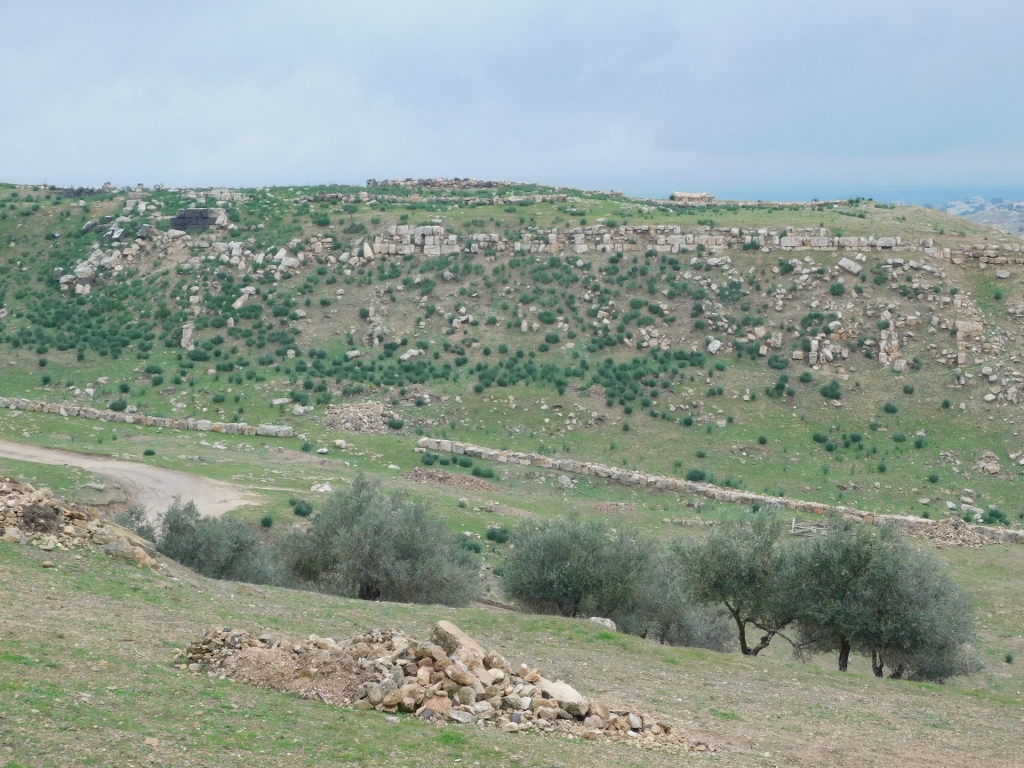 Abila, a detail
Abila, a detail
That other hill is in fact – a tell. Tell is an archaeological term for an artificial elevation created over the course of several generations living in the same spot. Over the centuries, on account of the piled up remains of human activities and ruins, the place starts to grow and in time something like a huge mound forms. Here in Abila, there are a couple of tells mentioned and I can only presume that what is seen in the photo above is one of them.
On the other hand, later I found some data saying that on the top of that elevation there are remains of one of the five Byzantine churches that have been discovered here so far. This one was built over the ruins of a Roman temple dedicated to Artemis.
What I want to say is that the history of this place is long. Moreover, people lived here already during the Bronze Age, while during the Hellenistic period a city was founded that belonged to the group of ten cities under the joint name of Decapolis. Later came the Romans, the Byzantines, the Umayyads and the Abbasids. Eventually, in 747, the city was hit by an earthquake which thoroughly demolished it. Today, the site is surrounded by numerous olive and pomegranate groves.
I agreed with the driver to wait for me in the car while I went down the hill and visited what I was interested in and this was the remains of yet another Byzantine church the pillars of which could be clearly seen in the distance. I could also see a large ancient paved street, as well as remains of numerous buildings that I wanted to see from up close, too.
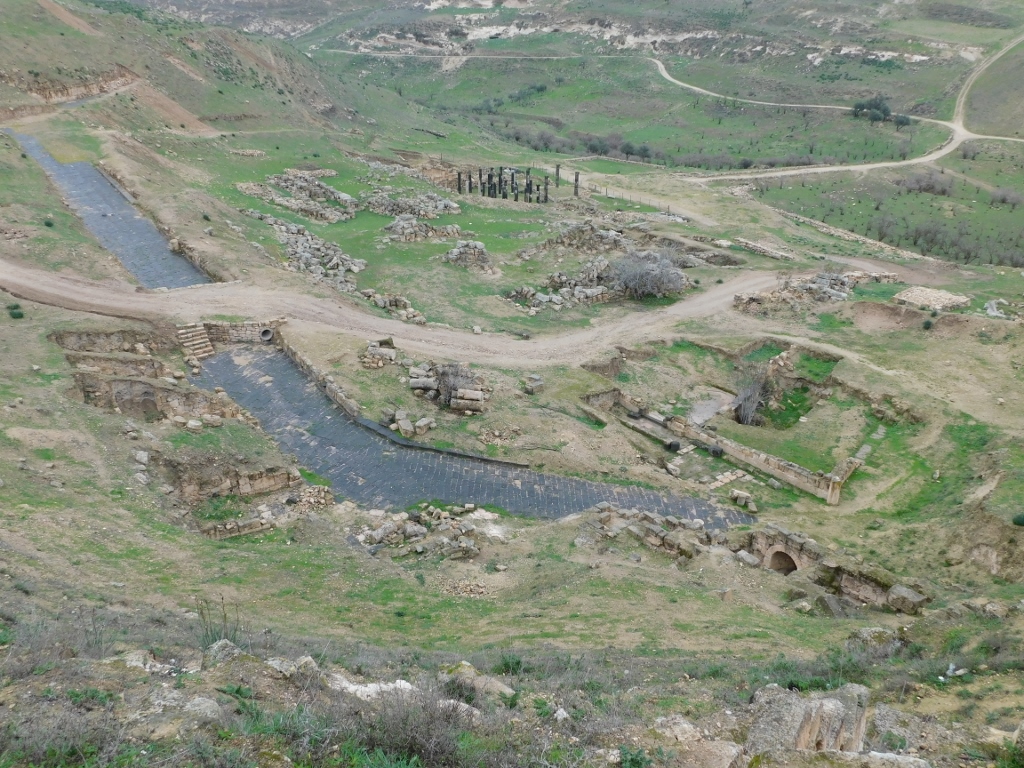 Abila, ruins in the valley
Abila, ruins in the valley
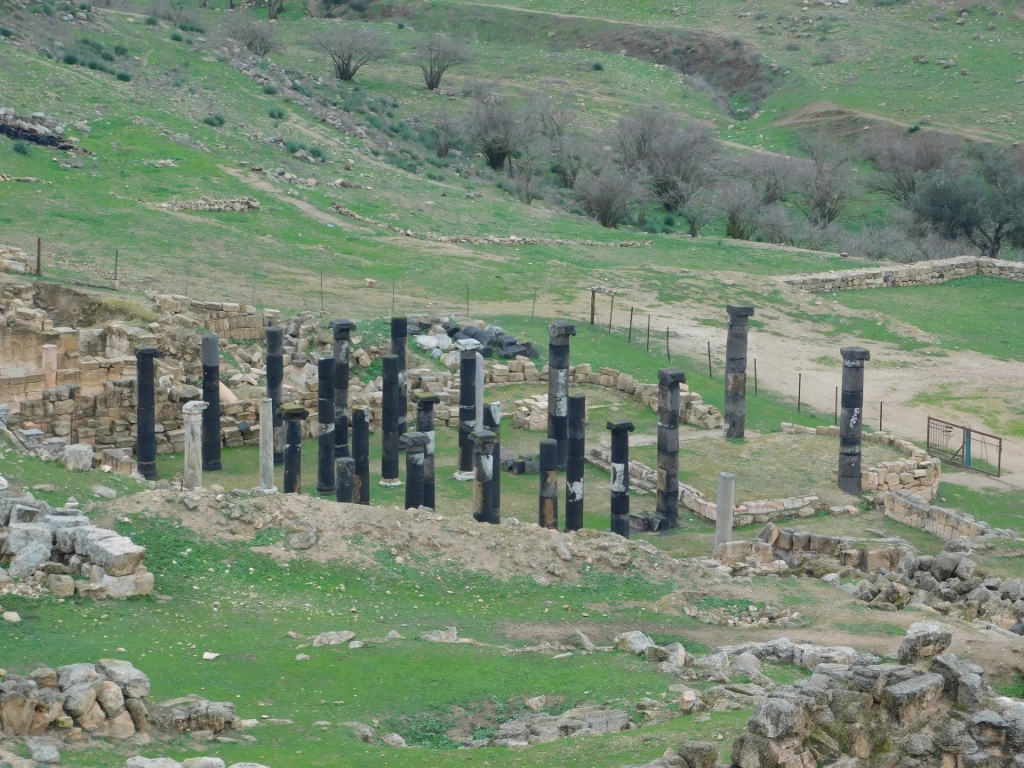 Abila, remains of a Byzantine church
Abila, remains of a Byzantine church
I went down the dirt road which at one point went over the paved ancient road. Taking into account that realistically I knew no details about this place, I felt no need to get off the dirt road and venture between the remains of the ancient city completely unknown to me. Still, I knew that here, in the area of the hill’s slope, there were remains of a Byzantine Monastic Complex and judging by the shape of the slope, it appears that there was also an ancient theatre.
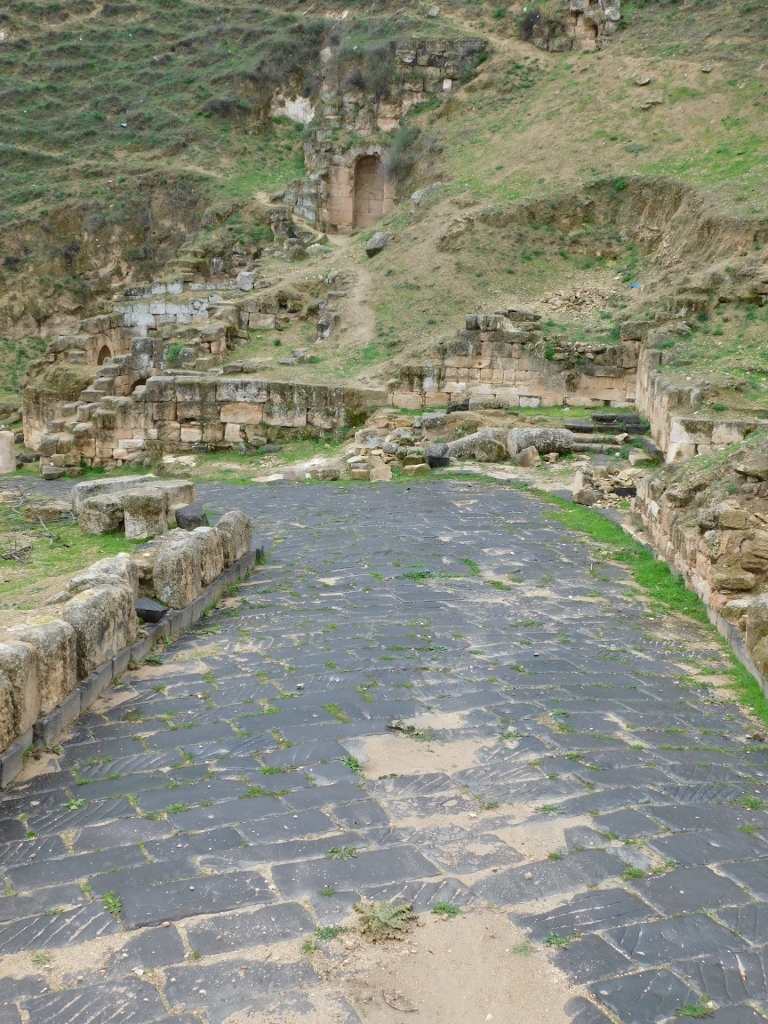 Abila, the ancient paved street and archaeological remains
Abila, the ancient paved street and archaeological remains
At some point I did start to walk between the ruins, because that allowed me to go in the direction of the remains of the church. The archaeological explorations conducted at the site have shown that there was an ancient bath complex here. The city also had its waterworks system and the additional water was supplied by an aqueduct.
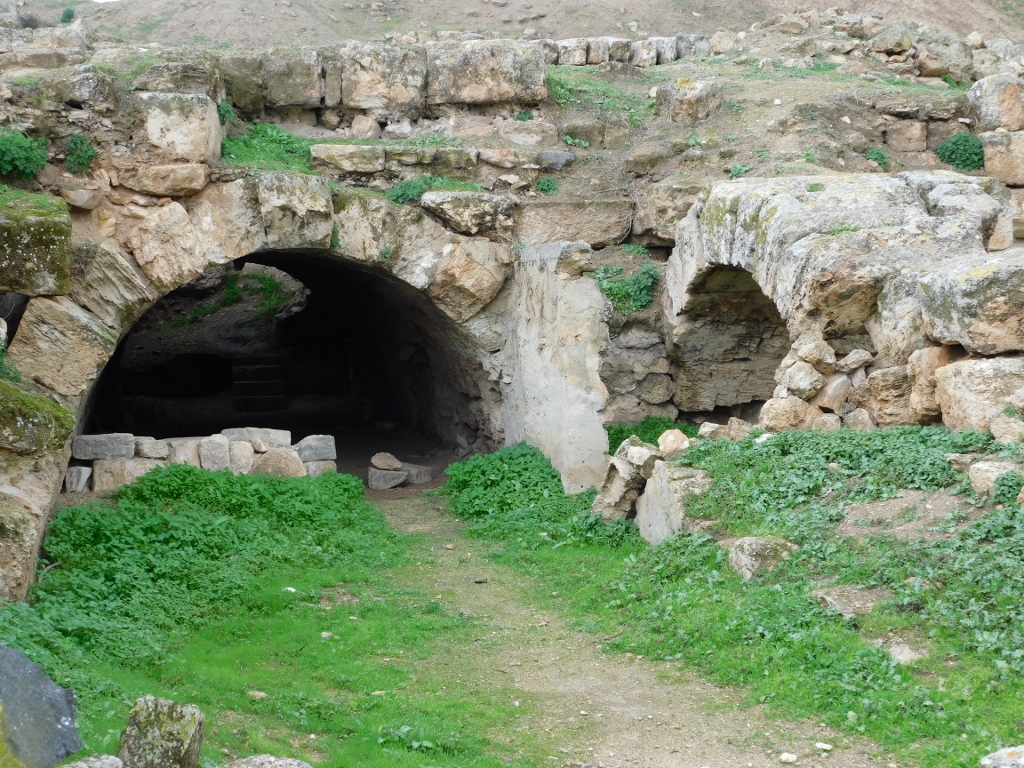 Abila, remains of the ancient bath complex
Abila, remains of the ancient bath complex
As it may be seen from the previous photos, only the proper experts can discern what this all is about. I thought it was a pity that the site had still not been developed enough for the laymen-visitors to be able to enjoy more in it. Because, according to what I’ve read on the internet later, there are many interesting segments here. Among other things, tombs within the Roman necropolis decorated by apparently very beautiful polychrome frescoes. I guess even today, without any kind of official organisation, it is possible, if the visitors have more time and interests, to go into some of these tombs that are like caves, but this requires not only the stamina (to put it politely), but also a lamp. My visit did not go in this direction at all and I simply went to the remains of the Byzantine church at the foot of the hills.
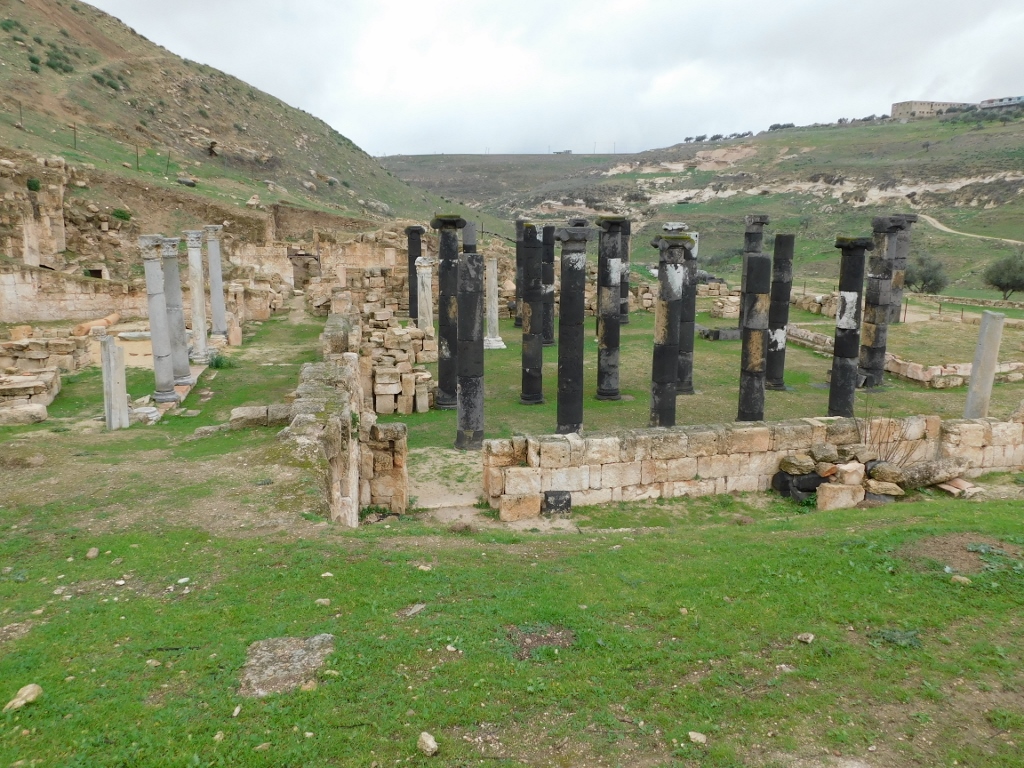 Abila, remains of the Byzantine church at the foot of the hills
Abila, remains of the Byzantine church at the foot of the hills
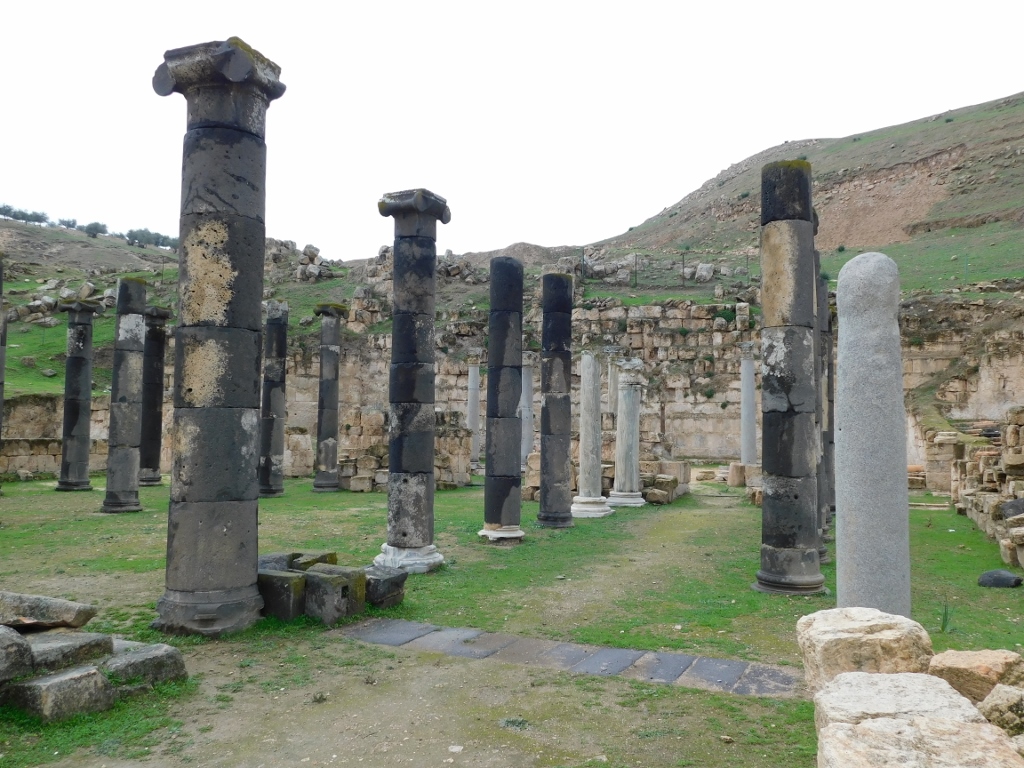 Abila, remains of the Byzantine church at the foot of the hills
Abila, remains of the Byzantine church at the foot of the hills
Having reached the remains of the Byzantine Church at the foot of Abila, it was clear what the ground plan of the structure was and there was an obvious difference between the columns. In addition to the fact that some were made of black stone and some others of gray stone, it was also possible to see that the black columns ended in Ionic capitals, while the gray ones had Corinthian ones. There, this was all I could deduct.
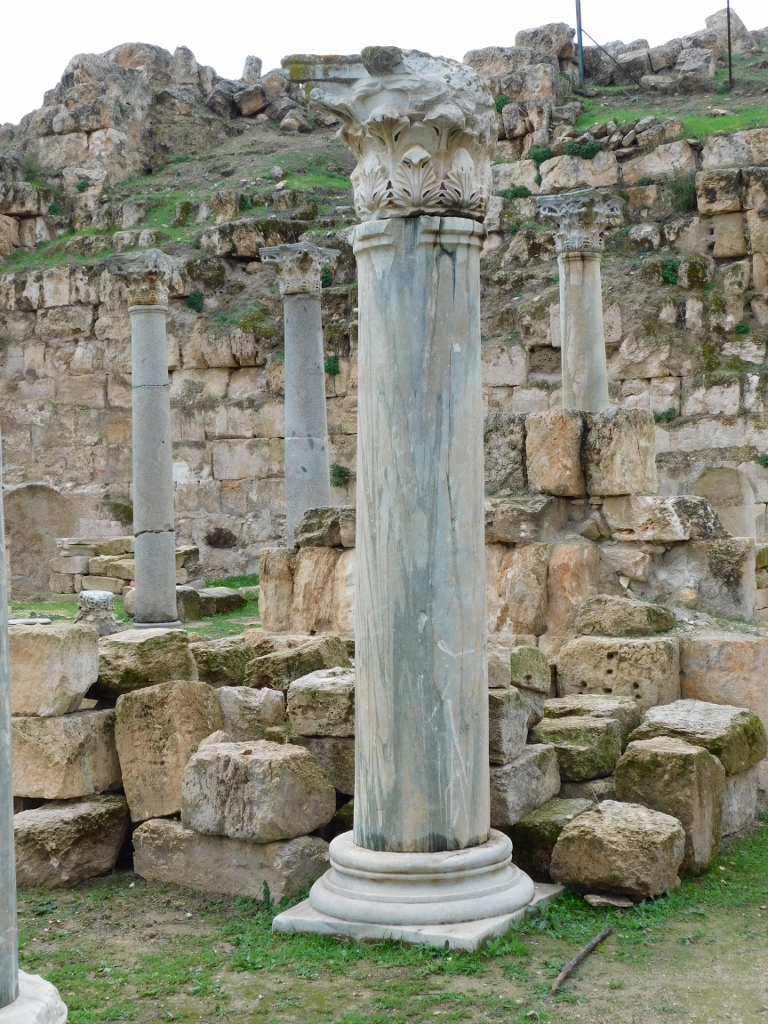 Column with Corinthian capital within the Byzantine Church at the foot of Abila
Column with Corinthian capital within the Byzantine Church at the foot of Abila
If one were to continue from this Byzantine Church further along the dirt road leading to the elevation on the opposite side of the valley, one would walk over the remains of a Roman bridge of modest size. However, it could not be clearly seen from the area around the Byzantine Church and there were no signs, so I was not in any mood to search for something without actually knowing where this was exactly. After all, I no longer had a lot of time (because of my prolonged stay in Umm Qais), while I still had a hill to climb in order to get back to the car waiting for me on the top.
I don’t know if I have mentioned that the drivers I went to these excursions with changed every day. And so, this was the case on this day, too, when unlike the earlier drivers this one did not speak any English, but he was in fact a very kind man and the impossibility of direct communication certainly did not bother us at all. Namely, he was absolutely ready – he had a mobile phone with an Arabic-English translation app. Although I am a professional translator/interpreter, which made me additionally aware of the shortcomings of these new systems, I must admit that these apps are quite good for some basic communication.
And so, earlier in the morning, we stopped at a coffee shop along the motorway to buy some Turkish coffee because I asked him for that. Later I found out that he was a new addition to the company renting cars with drivers, so he asked me for recommendation. Why not? He was indeed very kind. Along the way, whenever he saw something interesting or thought of something, he would take his mobile phone and say into it what he wanted in Arabic (these needed to be very short sentences) and then the application would most often interpret it so that it was clear. There were, of course, some translation that were completely meaningless, but then I would wave it off and he would try again, but in a different way and shorter. I would respond in the same way. So, we did communicate in the end using a very contemporary “basic tool.”
So, at some point I started to explain to him that according to my map, there was supposed to be an aqueduct and I must admit I imagined a large structure seen from all sides. He was really cooperative, but we actually had no clue as to where this was (as it turned out my map was imprecise and the data sparse). Along the way we saw a man and the driver asked him, but the former could not help us. Then we drove along the main road in the area a little up the road and a little down the road, following some signs, but in the end we could not find it and I told him that we could return to Amman. Later I managed to ascertain that the remains of the aqueduct I saw marked on the map are in fact within the site itself. Moreover, according to some other map it seems that I took photo of the parts of the aqueduct in the photo showing the paved street. Eventually, I was not sorry I did not find this properly, because these remains are obviously not as impressive as I thought them to be.
When we were about to get back to Amman and I was hungry, we stopped at some fast food restaurant. Meanwhile, chicken shawarma had become my favourite.
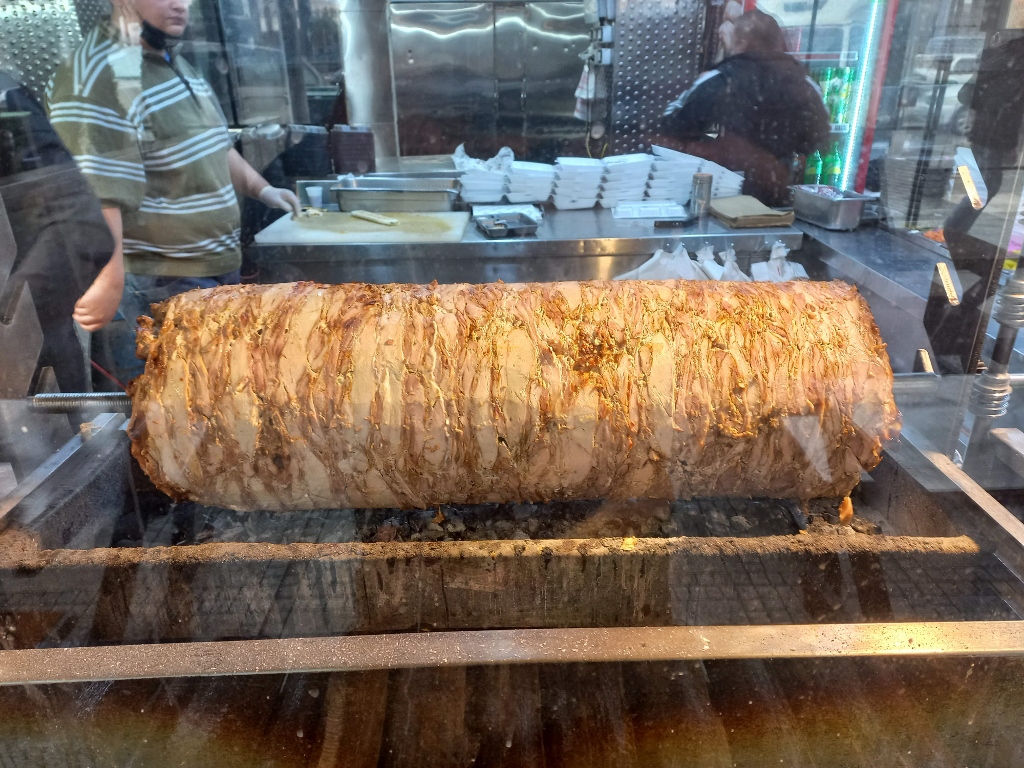 Chicken shawarma is being grilled
Chicken shawarma is being grilled
Since they offered different variations here, I pointed at a photo and they packed it all nicely for me. As it turned out, this was all much more than I thought, but I certainly did not complain. Let there be no mistake – under the pile of french-fries in the photo below there is chicken nicely wrapped in pita-bread and cut into bite-size pieces. I did not care about the dressings, but the pickles were great!
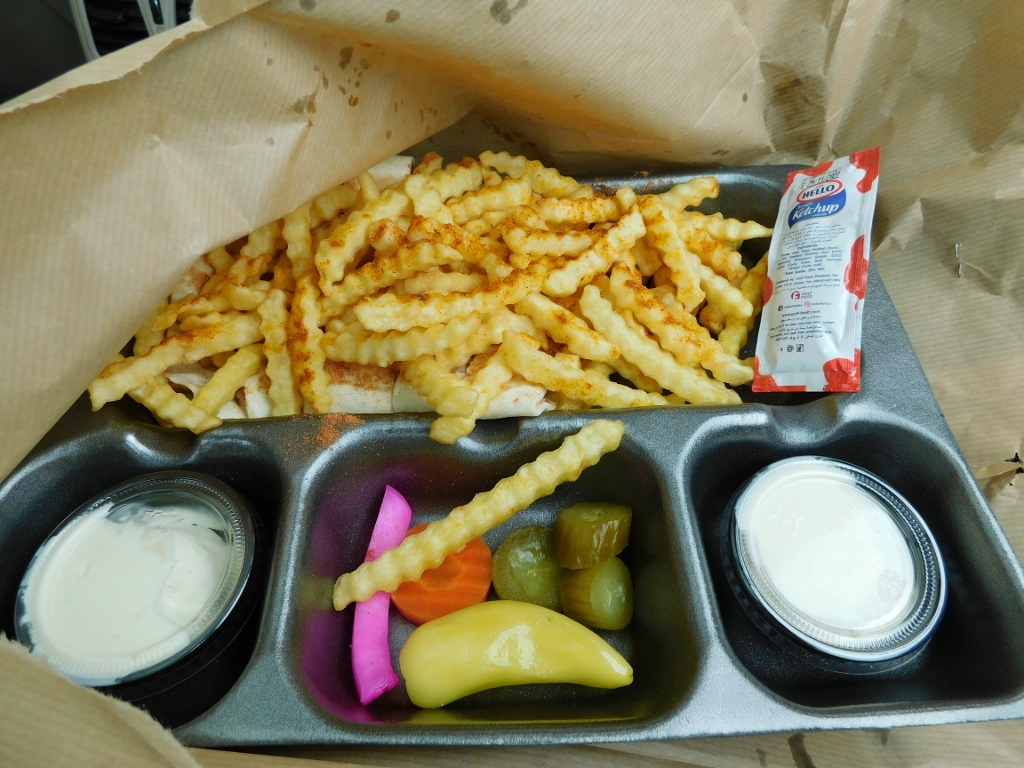 Fast food in Jordan
Fast food in Jordan
Since I returned to Amman while there was still daylight, I decided to go for a walk in the area where I was staying in order to visit a gallery I had read about. Do I need to emphasise that again I had to climb countless stairs on my way to the famous neighbourhood of Jabal al Lweibdeh.
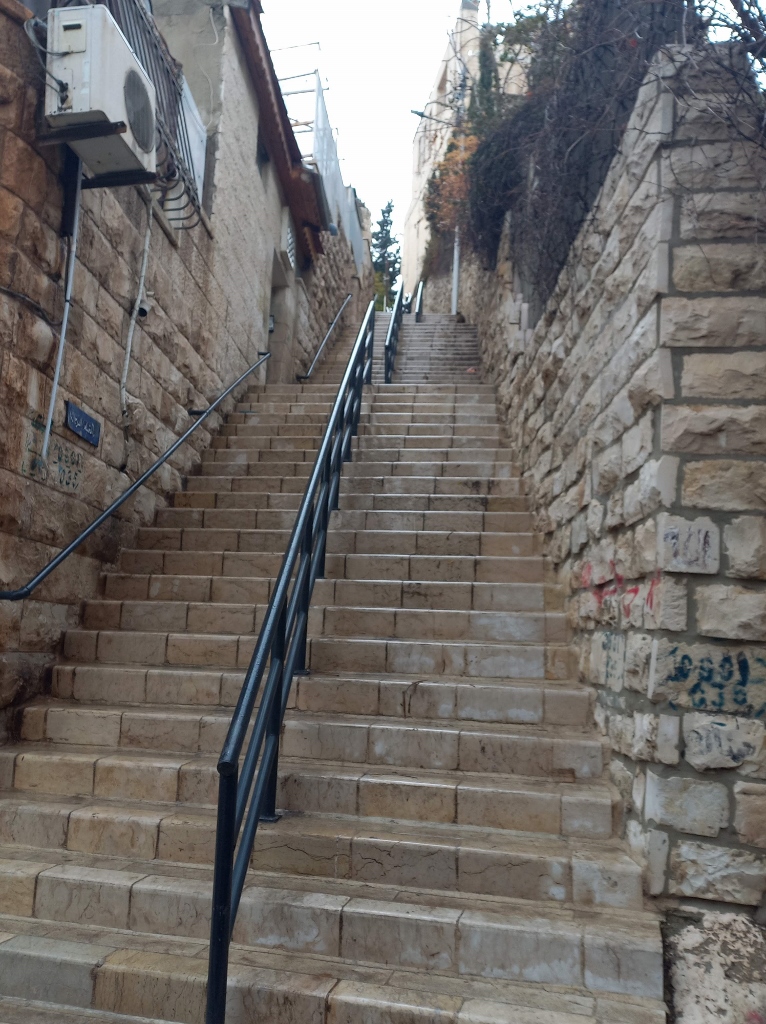 Stairs in Jabal al Lweibdeh
Stairs in Jabal al Lweibdeh
Looking for one gallery, I came across another one, so I entered. This was the Dar Al-Anda gallery founded in 1998 that is practically also a kind of a cultural centre, while the main emphasis is put on the contemporary art of authors from Jordan and the Near East. The gallery comprises two villas built during the 1930s. At some points the villas had rather deteriorated, but they were restored and now they provide very nice premises for an art gallery, along with the backyard.
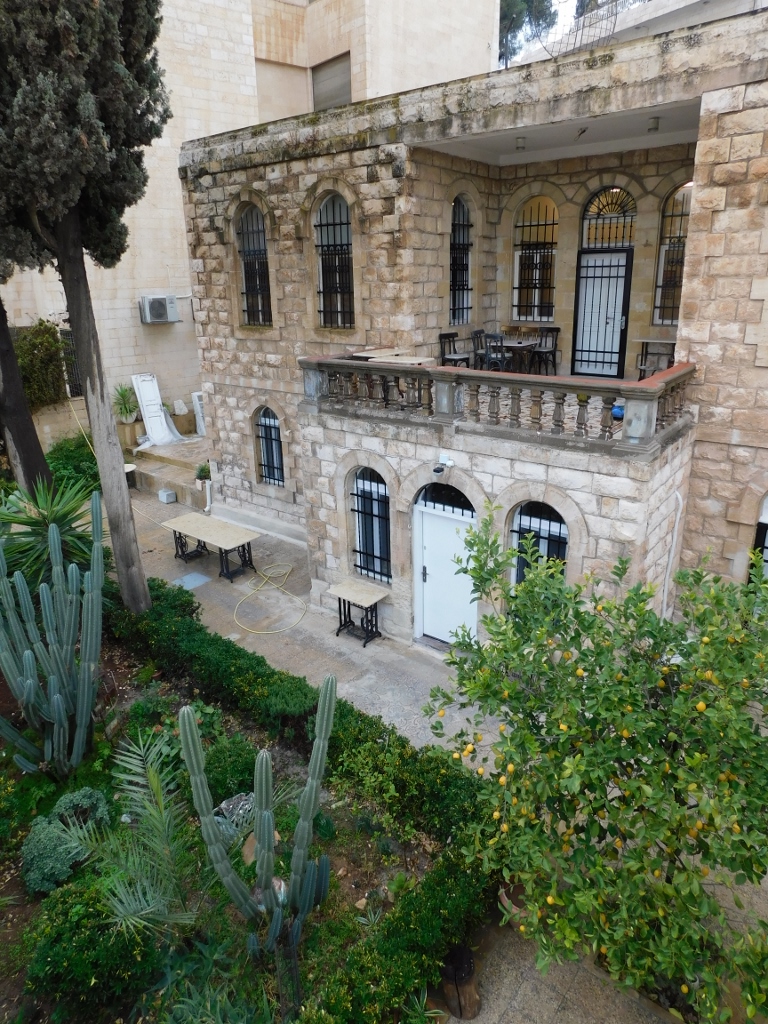 Part of the art gallery Dar Al-Anda
Part of the art gallery Dar Al-Anda
I quite enjoyed the visit to the gallery, but I realised it was not the one I had read about. This other one is just a couple of hundred metres away, so I went there, too. It was the Darat al Funun – Khalid Shoman Foundation.
This gallery, i.e., the foundation, deals with modern Arab art and it displays the artistic pieces within the premises on two adjoining plots of land separated by a passage with stairs. The foundation incorporates six historic houses built during the 1920s, as well as remains of a Byzantine church from the 6th century and a garden section.
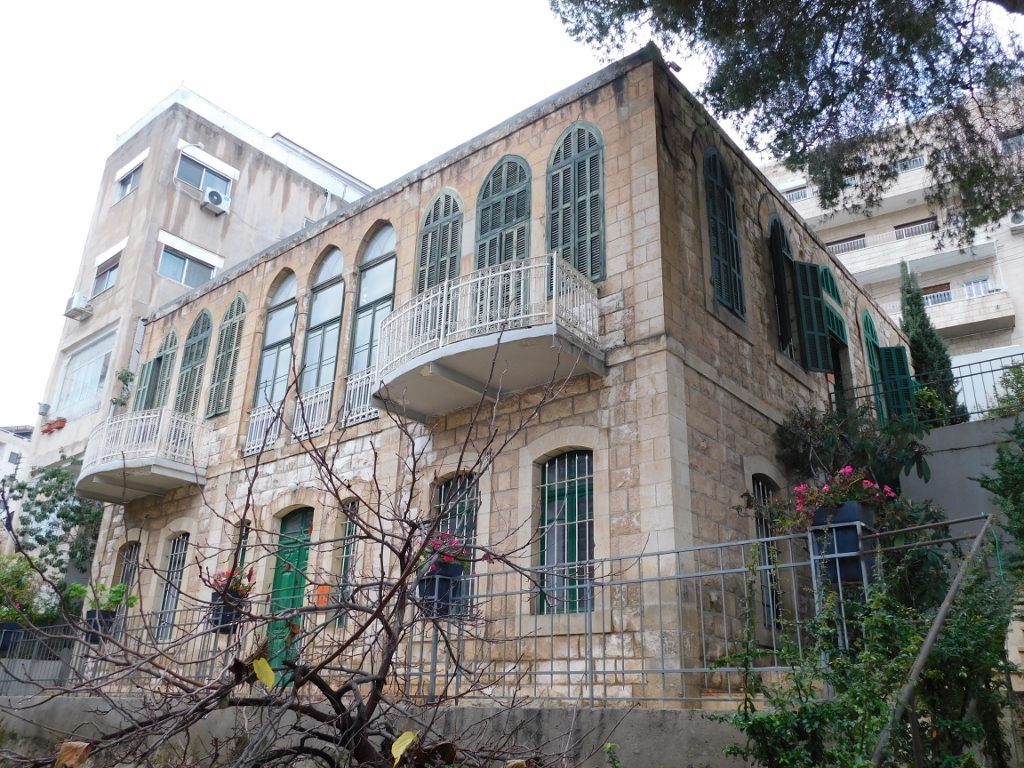 One of the houses displaying the art pieces
One of the houses displaying the art pieces
I enjoyed this visit as well and first I walked around the exhibition areas in the houses and then within the east plot of land I descended to the remains of the church.
So, Philadelphia (the present-day Amman) belonged to the Roman Province of Arabia that was set up in 106 CE. With time, Christianity became the official religion of the Roman Empire and this continued also in the Eastern Roman Empire later called Byzantium. This resulted in churches being built throughout the area that is Jordan today. At the end of the 6th century, in the place that is nowadays located within the Foundation, a Byzantine church was built on top of the foundations of a Roman temple dedicated to Heracles (formally speaking, the Roman hero and god was called Hercules, while Heracles was the Greek original, but all the documents on the foundation say „Roman god Heracles,“ so I just took it over).
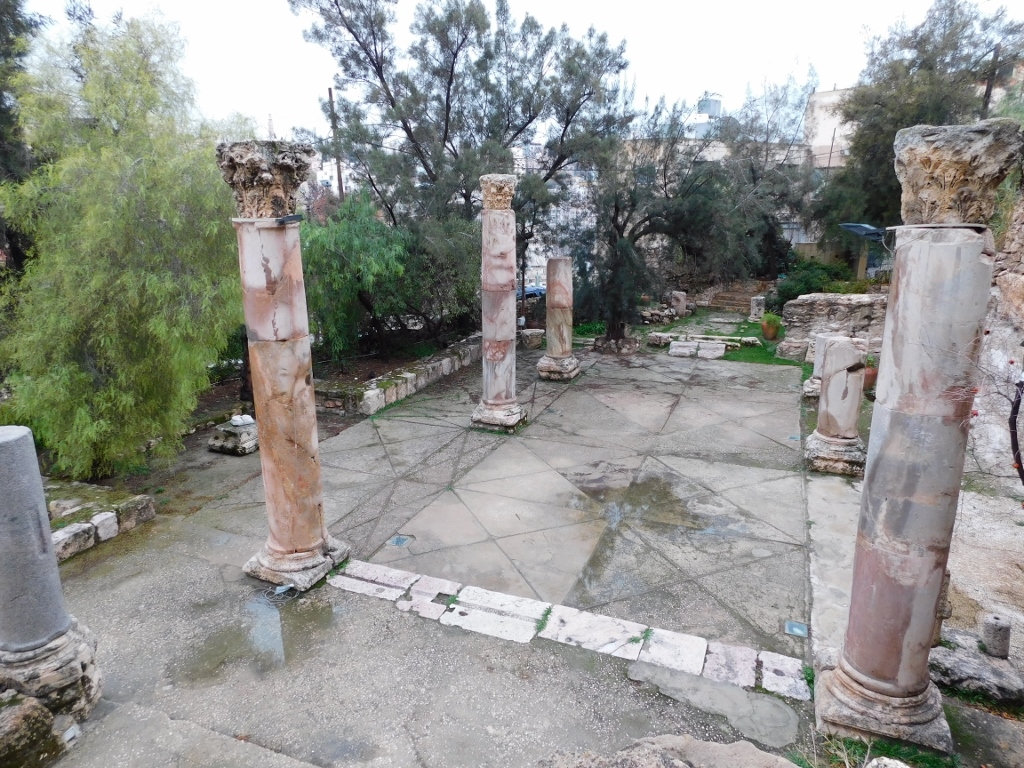 Remains of the Byzantine church within Khalid Shoman Foundation
Remains of the Byzantine church within Khalid Shoman Foundation
The church dedicated to St. George was abandoned in the 8th century, but this space was used up until the 20th century as a temple dedicated to the great Islamic sage el-Khadr. In 1993, excavations were conducted here, with subsequent restoration. Adjacent to the church there is also a small cave that is believed to have been used as a tomb or as the abode of a holy person.
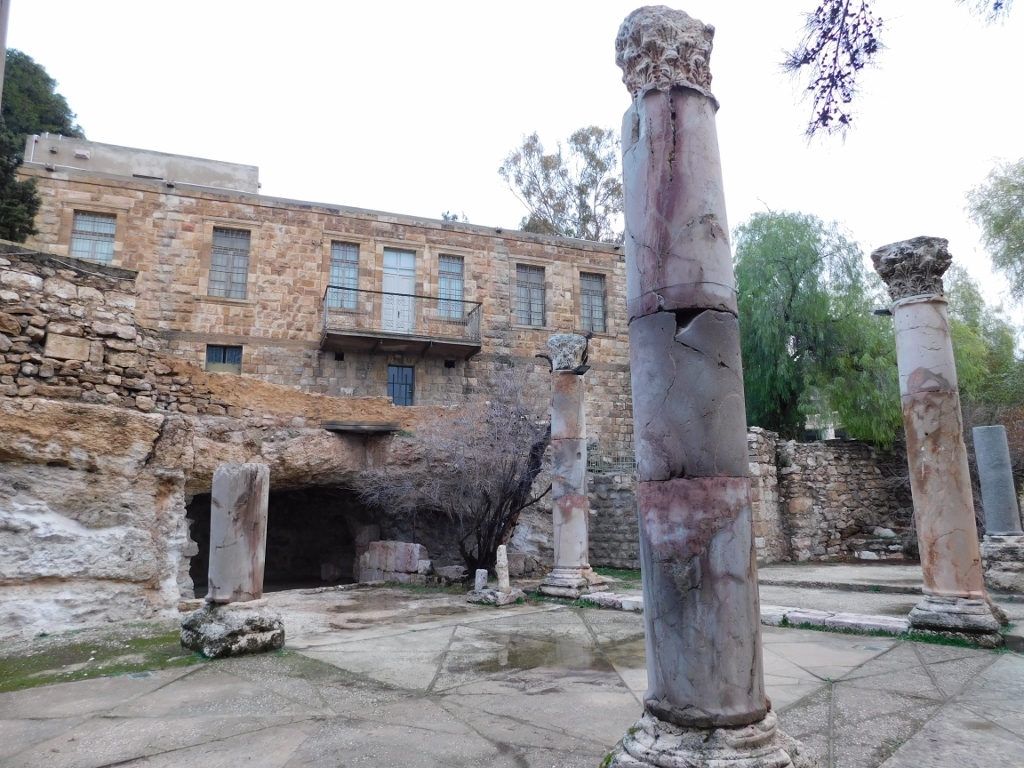 Remains of the Byzantine church and the cave under a building from the beginning of the 20th century
Remains of the Byzantine church and the cave under a building from the beginning of the 20th century
Very pleased with this walk, I went out using the back door at the bottom of the land parcel, which suited me fine, since a few hundred metres down I got directly to a sweet shop selling the sublime kunafa or knafeh. I have already written before about this fantastic sweet. Here they make them in large shallow pans and sell them by portions.
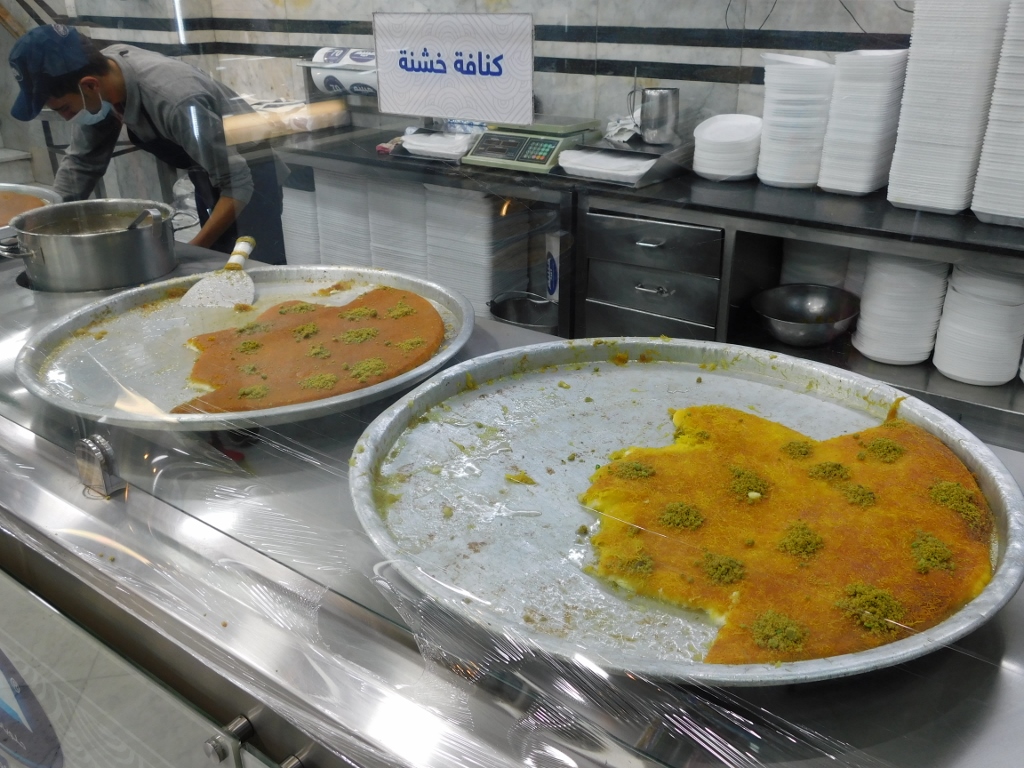 Shallow pans with knafeh
Shallow pans with knafeh
When I finished with the eating of knafeh, I continued slowly towards my hotel and thus I walked past the Grand Husseini Mosque again.
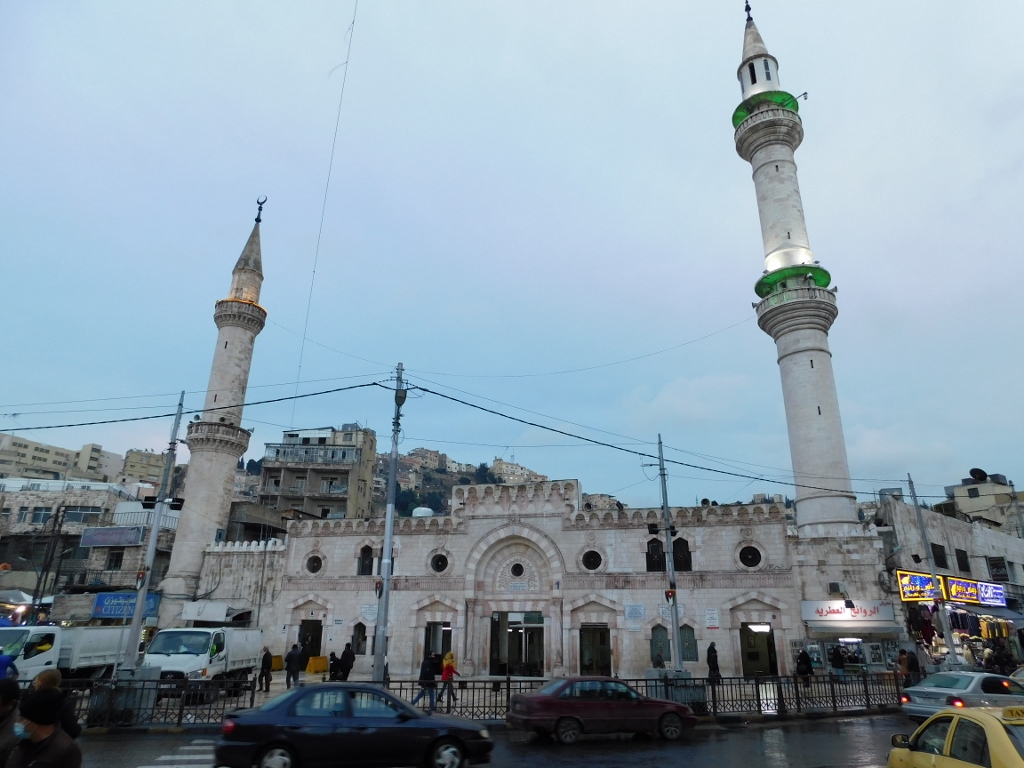 Grand Husseini Mosque
Grand Husseini Mosque
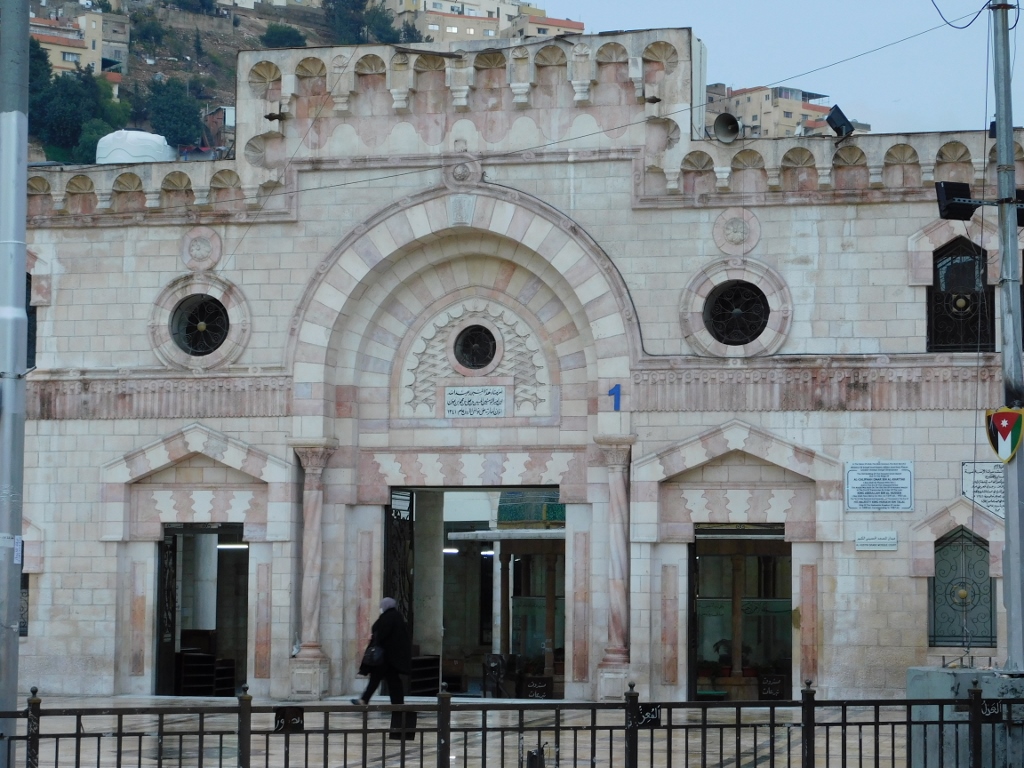 Grand Husseini Mosque, a detail
Grand Husseini Mosque, a detail
Soon the night fell and I did not visit anything else, withdrawing to my room instead, since the next morning I had to get up early again in order to go to yet another excursion. This time, the day was beautifully sunny, without a single cloud, which cannot be seen clearly in the following photo, but the photo does show the relative calm in the street in the part of Amman where I stayed.
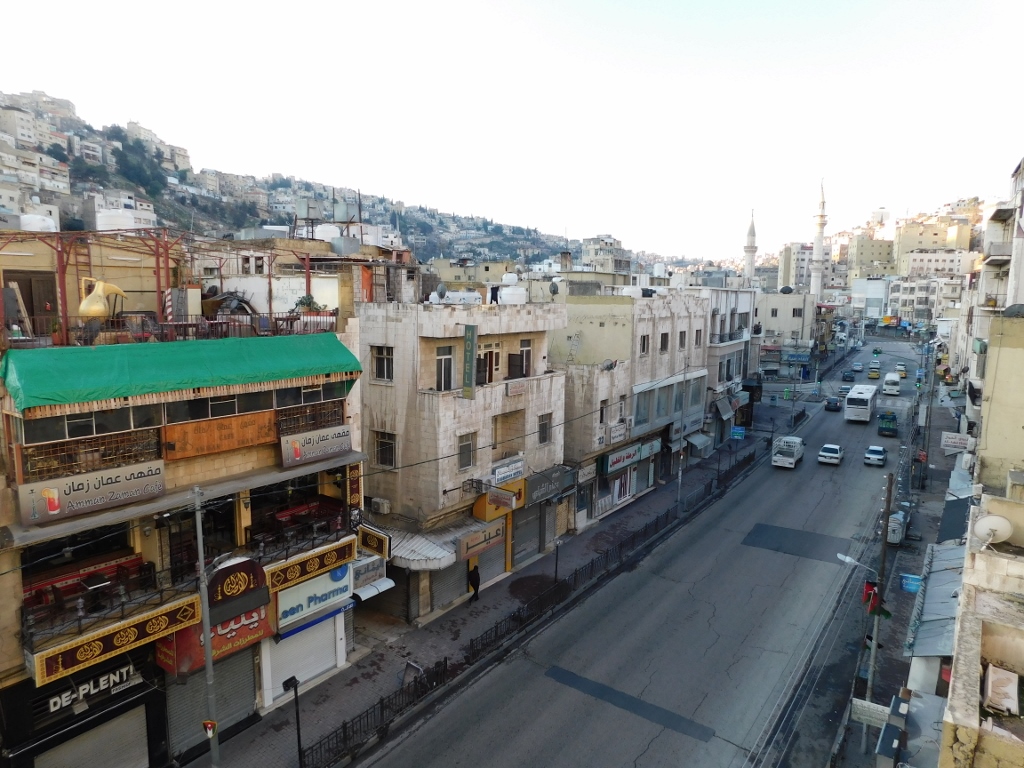 Downtown part of Amman and a little farther down the street the Grand Husseini Mosque
Downtown part of Amman and a little farther down the street the Grand Husseini Mosque
I took the photo above from the restaurant on the top of the hotel where I regularly had my breakfast. The breakfast was always the same, but I liked it and did not mind in the least its repetitive nature. It was a comparatively modest buffet, but it included some Jordanian and some international segments, so it was easy to choose. Each morning I took the same combination and, among other things, it included mutabal and hummus.
Both of these dishes, or dips rather since they are traditionally eaten by dipping pieces of pita bread into them, pertain in fact to the entire area of the Levant and are not exclusively Jordanian specialties. Moreover, a while ago I read that the Palestinians and the Israelis argue about who hummus belongs to, since both nations claim it as their national specialty. For my part, I got the first hummus recipe from a friend who got it from a Mother Abbess of a Serbian monastery. Of course, I don’t want to suggest that hummus originates from the Balkans, but rather I want to say that recipes for dishes come from people and then, if the dish is good, it simply spreads to other people. As for the hummus, I have always made it according to the recipe I got from this friend. And as for mutabal, I had to look for a recipe, but I also experimented a little. Mutabal is very similar to a dish, a dip, called Baba ganoush with some minor differences. I’m providing the basic mutabal recipe here, but I must add that once I added a few cubes of baked squash and it turned out to be quite tasty, but with a different colour (as seen in the photo below). Talking about colours, the height of my cooking craziness was when I added roasted purple yam. I don’t know what the residents of the Levant would think of my experiments, but I was quite pleased.
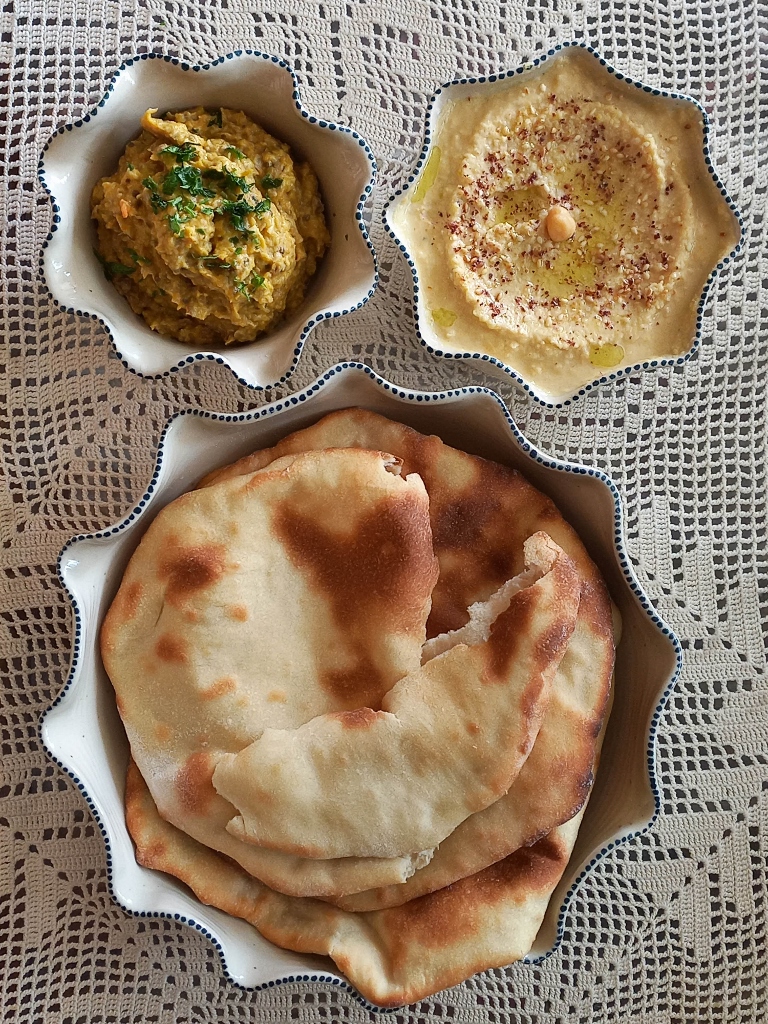 Mutabal with squash (up and left), hummus (the recipe will appear in one of the sequels of my travel stories) and my home-made pita bread (no recipe)
Mutabal with squash (up and left), hummus (the recipe will appear in one of the sequels of my travel stories) and my home-made pita bread (no recipe)
MUTABAL
- 1 medium sized eggplant
- 2-3 tbs of tahini paste
- 2-3 tbs of squeezed lemon juice
- 2 crushed garlic cloves
- 2 tbs of yoghurt
- salt to taste
Prick the eggplant with a fork and then roast it in the oven for about 30 minutes. Let it rest to cook a little, and then peel it.
Cut it into smaller pieces and put it in a bowl or a mortar. Add the rest of the ingredients (you can vary the quantities according to your taste) and mash the mixture either by a fork or by a pestle. You can also add chopped parsley.
I added roasted pumpkin to my mutabal in the photo, but pumpkin in this case is my invention and I did not eat this version of mutabal anywhere in Jordan. In order words, pumpkin is optional, it cannot diminish the tastiness of the dish, but it is not a part of the original recipe.